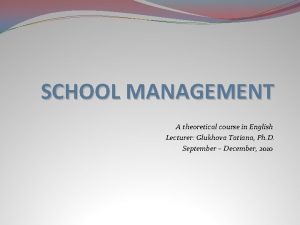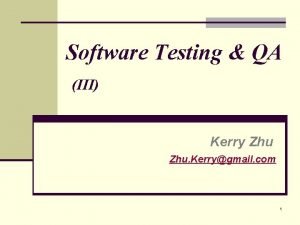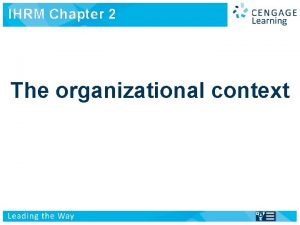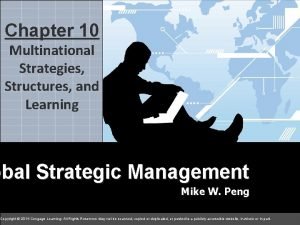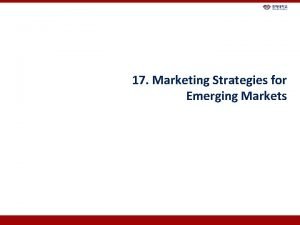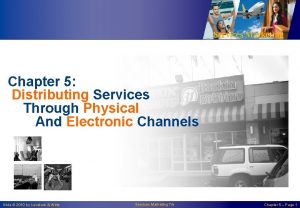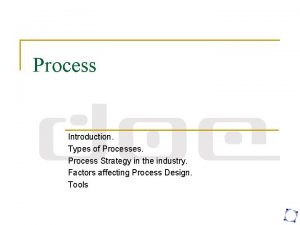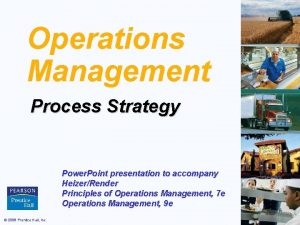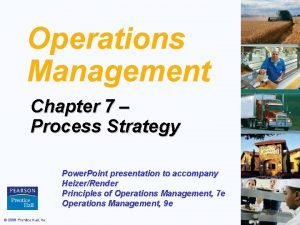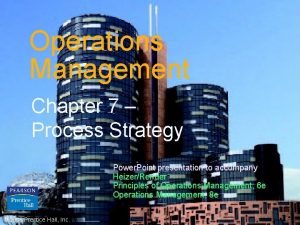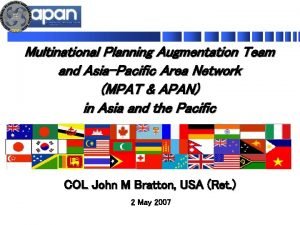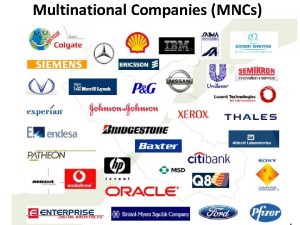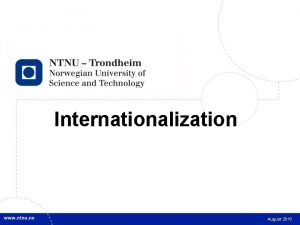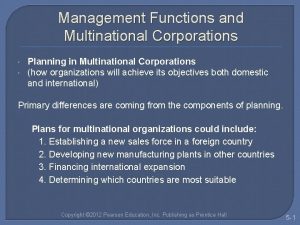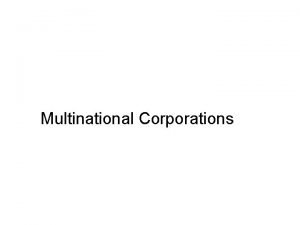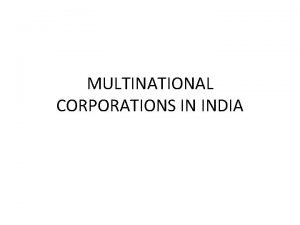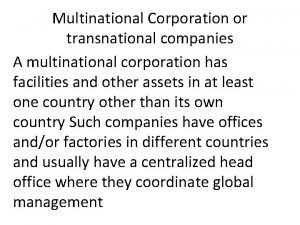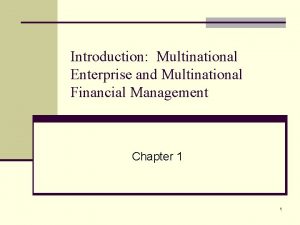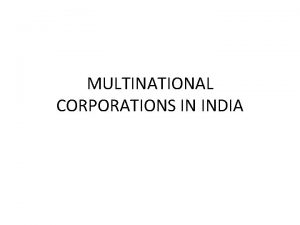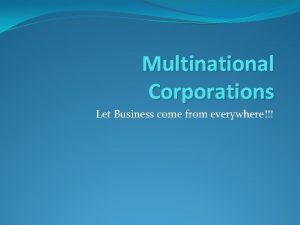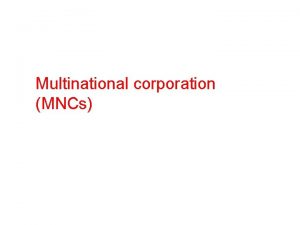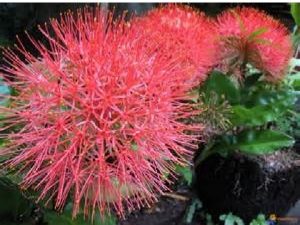Emerging Multinational Strategies Process of Internationalization Factors 5























- Slides: 23

Emerging Multinational Strategies

Process of Internationalization Factors (5 Ms): Markets (IPLC) Motivators (Determinants for Cross Border Business) Modes of Entry (Arms-Length, JVs, M&A, Greenfield) Management (Finance, Production, HR, Leader & Technology) Methods (Systems & Processes– execution & maintenance) Others: Morals (Ethics, Value & Culture) Metaphors (Image & Perceptions of Foreign Clients)

Infosys Tech Wipro Tech Ranbaxy Dr. Reddy’s Nalco Tata Steel # of employees 70, 000 80, 000 10, 500 7, 000 10, 000 41, 794 Sales for 2006 $2. 8 billion $3. 2 billion $1. 3 billion $ 0. 54 billion $1. 1 billion $5 billion Sales growth 05 to 06 33% 34% 50% 24% 20% 30% % sales abroad 98 % 77% 80% 83% 60% 37% Net Profit 2006 $ 0. 56 billion $ 0. 5 billion $0. 019 Billion $ 0. 042 billion $0. 35 billion $0. 85 billion # countries w/ subsidiaries ~ 30 ~50 ~35 ~12 ~25 # countries w manufacturing abroad global delivery model Global delivery model 9 2 0 8 Countries where working abroad America, Europe, Asia, etc America, Europe, Asia, Africa, etc America, Gulf, Asia, China, Europe America, Europe, Asia, Africa, etc Year firm founded 1981 1961 1984 1981 1907 Year started to work abroad 1987 1985 1977 1986 1987 1940 s export, 1999 mfg. # employees abroad 11, 000 15, 000 3, 000 1, 200 0 3, 612 # Indians abroad 8, 000* 11, 000* 1500 75 0 44 # foreigners at HQ -- -- ~ 50 -- -- --

Ownership structure Privatechairman +fam 80% Private Public Private Brief Description of the company’s activity programming Pharma Aluminum Steel Website Infosys. com Wipro. com Ranbaxy. com Dr. reddys. com Nalcoindia. com Tatasteel. . com

Russian Multinationals Industry Type – Product category Ownership Year Founded Year of Foreign market entry International Presence (sale, mfg. R&D) Size (revenue, employees, profits, growth) % of International sales Technology Focus Russian Economy & Characteristics

Leading Multinationals from Russia http: //www. rusal. com http: //www. severstal. ru http: //www. ibs. ru http: //www. sistema. ru/ http: //www. sitronics. com/ http: //www. transas. com/ http: //www. pcmp. ru

Summary of Russian Companies Rusal Severstal IBS Sitronics Transas PCMP # of employees 110, 000 150, 000 4000 10, 000 >1000 1450 Sales for 2006 $6. 7 billion US$12. 5 billion $575 million $7. 59 billion $109 million $ 50 million % sales abroad 81% 60% 7 -8% 50% 80% Profit 2006 $8, 2 Bil US$3. 0 bil Profitable US$1. 6 bil Profitable # of foreign countries where working 50 About 10 25 (export to 60) 100 65% Europe 35% Asia # of countries w/ manufacturing abroad 13 3 0 0 List of countries where working abroad Australia, USA, Italy, Guinea, France, etc. Nigeria, etc. USA 50% of sales, some. Europe, Ukraine programmers, UK, etc. 16, Mainly CIS, also Czech, Greece, USA. 100 countries: USA, UK, Germany, Sweden, China, etc. Sell all over the world, but all activity done from HQ Year founded 2000 1993 1992 1993 1990 2000 Year started to work abroad 2000/much 2004 2000 2001 1992 1990

# employees abroad >5000 About 30 About 200 n/a 250 0 # of Russians abroad n/a 10 90 n/a <30 + immigrant 0 # foreigners at HQ A few 0 0 1 0 Ownership structure Private Publicly listed NY, London, R Private Brief Description of the company’s activity The largest aluminum company in the world, only top 3 which is privately held One of the world’s top six steel producers, owns Rouge (USA) retirement 71%Italy Lucchini IBS is Russia’s leading programming company. Much offshore programming Key Regional ITT Co, part large Rus Systema group, Telecom/ electronics solutions, software, equipment Software, hardwareintegrated solutions, electronic navigation for shipping and aviation Solar cell production for solar energy panels--accounts for 15% of the total world production Website rusal. com Severstal. ru www. ibs. ru www. sistema. ru/ Transas. com www. pcmp. ru

Russian Economy - Characteristics 1985 – 1990 Perestroika (program of economic restructuring) Glasnost (liberalize freedom of press) Privatization: http: //findarticles. com/p/articles/mi_m 1132/is_n 6_v 44/ai_12841723 http: //econpapers. repec. org/paper/wpawuwpdc/0312002. htm http: //en. wikipedia. org/wiki/Boris_Yeltsin High rates of Inflation in the early 90 s State ownership to Private Ownership Nature of entrepreneurs Nature & characteristics of business focus Focus on technology Privatization to Globalization

Chinese Economy Characteristics

Chinese Multinationals Industry Type – Product category Ownership Year Founded Year of Foreign market entry International Presence (sale, mfg. R&D) Size (revenue, employees, profits, growth) % of International sales

Leading Multinationals from China http: //www. smtcl. com/web/en/aboutus/index. html http: //www. dmtg. com http: //wwwen. zte. com. cn/ http: //www. huawei. com/ http: //www. tcl. com/main_en/ http: //www. konka. com/about. jsp

Summary of Chinese Companies SMTCL DMTG ZTE HUAWEI TCL KONKA # of employees 8, 487 N/A 30811 61000 63, 000 2006 Sales $690 Mill $1. 2 Bill $3. 0 Bill $8. 6 Bill $6. 2 Bill 1. 7 Bill Sales growth 2005 to 2006 22% 23% 7% 45% 11% %sales abroad N/A 44% 65% 51% 13% Profit 2006 $17 Mill $77 Mill $140 Mill N/A - $254 Mil $13 Mill # of foreign countries where working 1 sub + 33 overseas sales agents 22 subs, jvs & + cooperation 20 + 100 With 6 R&D centers 80 12 R&D centres 20 mfg units 5 subs + Sales to 100 from HQ # of countries w/ mfg. abroad 1 Germany 2 USA + Germany 4 N/A 20 Contract factories in 5 -don’t own India, Indonesia, Mexico, Turkey Countries where working abroad Germany (mfg. ) America (mfg. ), Ingersoll Rand German (mfg. ) Zimmermann Italy Most of world 14 WOS R&D centres in N America, Europe & Asia Russia, Africa, now most of world Most of world US, HK, Slovakia, Indonesia, Thailand, Mexico, etc Year founded 1949 1948 1985 1988 1981 1980

Year first year started to work abroad Export before 1984 M&A 2002, export from 1990 2000 1999 Bangalore R&D center in 1999 1998 1996 # employees abroad N/A N/A 11, 000 N/A # of Chinese abroad N/A N/A N/A # foreigners at HQ N/A About 100 N/A N/A Ownership structure of firm State owned 32% state, 0. 013 TMT, Tradable shares 68% Privately Owned by management and many employees State 13%, Private 26%, TMT 13% Tradable share 48% Public, traded on HK Stock exchange Brief Description of the company’s activity Machine tool production and sales; complex systems Telecom network equipment mfg. & sale Telecom network equipment manufacturing &sales TVs and other home electronic appliances www. tcl. com www. konka. com Technology centres – CNC, boring, driling Commits 10% for R&D 14 WOS R&D 50 acad inst. R&D: 10% ( 10% pre research) 22695 appli 3335 patents 7% of 3 GPP patents Cisco -2003 Website www. smtcl. com www. dmtg. com zte. com. cn huawei. com

Summary of the article on Emerging Multinationals

Key Differences b/w EMNCS & Western MNCS Emerging multinationals tended to internationalize much faster and often skipped some modes in the normal Uppsala model progression from low commitment to high commitment modes. Emerging multinationals normally did not expand to gain access to inexpensive resources (e. g. , inexpensive labor) or to gain access to additional markets to sell products to Instead to acquire respected brands and modern technology

Emerging multinationals normally internationalized to improve their position in their home market rather than to access other markets For many emerging multinationals the greatest challenges were finding ways to overcome the problem of a negative country image and the lack of ability of foreigners to differentiate between firms in the same industry from the same transforming economy A strong focus on quality as shown by getting international quality certificates proved to be one useful way

Emerging multinationals normally found it easier to do business in other developing countries since they were better able to deal with these challenging environments than their western counterparts Extreme lack of international experience and foreign language skills among emerging multinationals - As a result, paying significant attention to recruiting for and developing these skills proved to be especially important for emerging multinationals EMNCS, the new kids of global business are serious challengers to the existing & traditional Global players

Additional perspectives on EMCS 1. Emerging multinationals had a pool of motivated manpower to explore the world as compared to western multinationals whose manpower considered being sent outside the home country as a punishment

2. How are the EMNCS leveraging their local culture & values into building quality? India: discipline and strong principles; cultural? China: Russia: strong nationalistic feeling (directing their energy for mass scale production) ? Home grown Technology and scientific manpower ? Strategic Convergence & Strategic Decay, Gary Hamel(2000),

3. How are they leveraging the best local talent from a much bigger pool? Larger population v/s lower opportunity – leads to higher domestic competition Willingness to work harder Higher level of competitiveness Majority of population in middle income group: At lower level of self – seeking material achievements Local Talent is thirsty to grow – wings of fire

Questions to be answered 1. How do the EMNCS acquire assets and competence in their respective economies? 2. How do they reconfigure their assets in the global market to compete? 3. Do EMNCS have different management practices compared to their triad counterparts?

4. How are they amassing national assets (through favorable local Government policies) in their respective nations to grow to global size? 5. If historically, MNCs have been observed to behave as stateless corporations, how will the EMNCS contribute to their respective nations in the future? 6. Can the EMNCS discover new routes and strategies and not tread the same old path of competition?
 Globalization vs internationalization
Globalization vs internationalization Internationalization of higher education in the philippines
Internationalization of higher education in the philippines Kerry zhu
Kerry zhu Stages of internationalization in ihrm
Stages of internationalization in ihrm Balagtas
Balagtas Multinational strategies and structures
Multinational strategies and structures Marketing strategies for emerging markets
Marketing strategies for emerging markets Multinational capital budgeting example
Multinational capital budgeting example Distributing services in service marketing
Distributing services in service marketing Site vs situation examples
Site vs situation examples Abiotic
Abiotic Abiotic vs biotic factors
Abiotic vs biotic factors Abiotic vs biotic factors
Abiotic vs biotic factors Abiotic vs biotic
Abiotic vs biotic Situation vs site
Situation vs site Highest common factor of 36 and 48
Highest common factor of 36 and 48 What are the factors of 7
What are the factors of 7 Gcf of 25 and 30
Gcf of 25 and 30 Yamazumi
Yamazumi Repetitive process in operations management
Repetitive process in operations management Process strategy in operations management
Process strategy in operations management Operations management chapter 7 solutions
Operations management chapter 7 solutions Disadvantages of multinational corporation
Disadvantages of multinational corporation Multinational planning augmentation team
Multinational planning augmentation team
